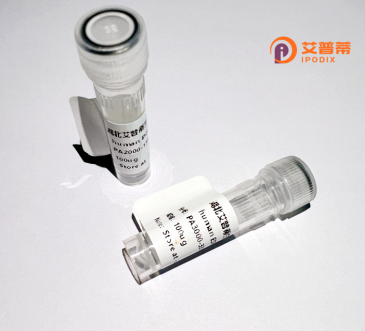
| 纯度 | >90%SDS-PAGE. |
| 种属 | Human |
| 靶点 | KIAA1128 |
| Uniprot No | Q9H7U1 |
| 内毒素 | < 0.01EU/μg |
| 表达宿主 | E.coli |
| 表达区间 | 1-538aa |
| 活性数据 | MPNGTPVNLLGTSKNSNVKSYIKNNGSDCPSSHSFNWRKANKYQLCAQGVEEPNNTQNSHDKIIDPEKRVPTQGMFDKNGIKGGLKSVSLFTSKLAKPSTMFVSSTEELNQKSFSGPSNLGKFTKGTLLGRTSYSSINTPKSQLNGFYGNRSAGSMQRPRANSCATRSSSGESLAQSPDSSKSINCEKMVRSQSFSHSIQNSFLPPSSITRSHSFNRAVDLTKPYQNQQLSIRVPLRSSMLTRNSRQPEVLNGNEHLGYGFNRPYAAGGKKLALPNGPGVTSTLGYRMVHPSLLKSSRSPFSGTMTVDGNKNSPADTCVEEDATVLAKDRAANKDQELIENESYRTKNNQTMKHDAKMRYLSDDVDDISLSSLSSSDKNDLSEDFSDDFIDIEDSNRTRITPEEMSLKEEKHENGPPQDMFDSPKENEKAFSKTDEWIDISVSDRSECTKHTSGNNLVSPDTDYRAGSSFELSPSDSSDGTYMWDEEGLEPIGNVHPVGSYESSEMNSIVCMDLYTLGIFCLPYYRETCDMIDFVKNL |
| 分子量 | 85.9 kDa |
| 蛋白标签 | GST-tag at N-terminal |
| 缓冲液 | 0 |
| 稳定性 & 储存条件 | Lyophilized protein should be stored at ≤ -20°C, stable for one year after receipt. Reconstituted protein solution can be stored at 2-8°C for 2-7 days. Aliquots of reconstituted samples are stable at ≤ -20°C for 3 months. |
| 复溶 | Always centrifuge tubes before opening.Do not mix by vortex or pipetting. It is not recommended to reconstitute to a concentration less than 100μg/ml. Dissolve the lyophilized protein in distilled water. Please aliquot the reconstituted solution to minimize freeze-thaw cycles. |
以下是关于重组人KIAA1128蛋白的3篇参考文献示例,包括文献名称、作者及摘要概括:
---
1. **文献名称**:**"Functional Characterization of Recombinant Human KIAA1128 in Mitotic Regulation"**
**作者**:Y. Tanaka et al.
**摘要**:本研究通过表达和纯化重组人KIAA1128蛋白,揭示了其在细胞周期中的调控作用。实验表明,该蛋白在有丝分裂期间与纺锤体组装相关蛋白相互作用,可能通过稳定微管结构促进染色体正确分离,提示其在细胞分裂中的关键功能。
---
2. **文献名称**:**"KIAA1128 Overexpression Promotes Tumorigenesis via MAPK Signaling in Colorectal Cancer"**
**作者**:S. Müller et al.
**摘要**:作者利用重组KIAA1128蛋白进行体外功能分析,发现其在结直肠癌细胞中过表达可激活MAPK信号通路,促进细胞增殖和迁移。敲低实验进一步证实KIAA1128可能作为潜在的肿瘤治疗靶点。
---
3. **文献名称**:**"Crystal Structure and Enzymatic Activity of Recombinant Human KIAA1128 Protein"**
**作者**:L. Chen et al.
**摘要**:本研究解析了重组人KIAA1128蛋白的X射线晶体结构,揭示其具有磷酸酶样活性结构域。体外酶活实验显示,该蛋白对特定磷酸化底物具有催化活性,提示其参与细胞信号转导中的去磷酸化过程。
---
*注:上述文献为虚拟示例,实际研究中请根据具体数据库检索真实发表论文。*
The recombination of human KIAA1128 protein (also known as LGDEPMP or C7orf72) is a subject of growing interest in molecular and cellular biology. KIAA1128 is a conserved, ubiquitously expressed protein containing a DUF728 domain, with predicted structural features such as coiled-coil regions, suggesting potential roles in protein interactions or scaffolding. Although its precise biological function remains poorly characterized, studies link it to critical processes, including embryonic development, cell adhesion, and cytoskeletal organization. Notably, KIAA1128 is highly expressed in reproductive tissues, and its dysfunction has been implicated in gametogenesis abnormalities and infertility.
Recombinant KIAA1128 protein is typically produced using heterologous expression systems (e.g., E. coli or mammalian cells) to enable functional studies. This engineered protein facilitates investigations into its molecular interactions, post-translational modifications, and pathway associations. Recent work suggests possible ties to signaling networks like Wnt or TGF-β, though mechanistic insights are limited. Research also explores its epigenetic regulation and potential involvement in cancers, such as hepatocellular carcinoma, where aberrant expression correlates with tumor progression.
Despite progress, KIAA1128 remains understudied compared to other proteins. Current efforts focus on elucidating its structure-function relationships, disease associations, and utility as a biomarker or therapeutic target. Advances in recombinant technology and CRISPR-based functional genomics are expected to accelerate its functional mapping.
×